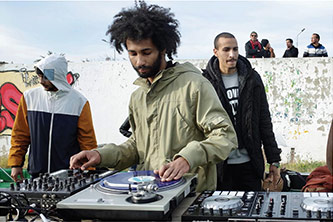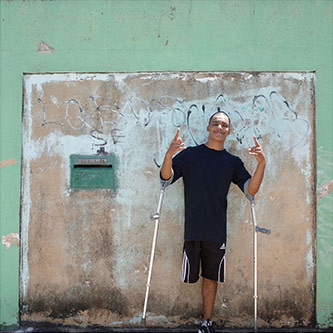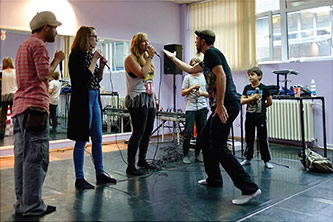American Music Review
Vol. XLVI, Issue 2, Spring 2017
By Mark Katz, University of North Carolina, Chapel Hill
“I love America—I dream of going to America!” Exclamations like this greeted me over and again from the Algerians and Tunisians I had just met. Their warmth and good will surprised me. It was February 2017, hardly two weeks since President Trump had issued Executive Order 13769, widely criticized as a “Muslim Ban.” Ostensibly intended to protect the United States from foreign terrorists, the order was seen as part of a broader pattern of xenophobic policies and rhetoric coming out of our country.1 Given such palpable hostility, why would people of these Muslim-majority nations so admire the US, why did they yearn to visit its shores?
The answer is American culture.
During my North African trip I interacted with dozens of young, working-class Muslim men and women. They were passionate about the United States, but not because of our government; many expressed deep concern about our new president and his administration. (Several times I heard variations of this statement: “I love America—but your president is crazy!”) They love our culture and the ideals of freedom and opportunity that it embodies. And for so many of the young people I met, hip-hop is at the center of American culture. “I fell in love with the music, the way they dress, the way they dance, the way they speak, the way they do their thing,” a twenty-five-year-old Tunisian DJ named Rami told me. Hip-hop, he said, has “played an important role in my life.”2
It is this deep connection to hip-hop, one felt by youth all over the world, that brought me to Algeria and Tunisia, and has spurred my work in more than a dozen other countries over the past three years. I direct Next Level, a program funded by the US Department of State’s Bureau of Educational and Cultural Affairs and administered by the University of North Carolina at Chapel Hill and Meridian International Center. A direct descendent of the “Jazz Ambassadors” tours that sent Louis Armstrong, Dave Brubeck, Duke Ellington, Dizzy Gillespie, and Benny Goodman around the world during the Cold War, Next Level is a form of people-to-people diplomacy, where citizens of different countries work together to promote mutual understanding and cooperation.33 Rather than sponsoring concert tours, however, Next Level offers workshops, led by US hip-hop artists and educators, for young people in underserved communities. These intensive workshops are designed to develop skills in beat making, dancing, DJing, and rapping, and are intended to promote constructive self-expression, entrepreneurship, and conflict reduction. Between May 2014 and May 2017, Next Level has held one- to two-week residencies in nineteen different countries on five continents, and has brought young artists from each of those countries to the United States for artistic and professional development workshops; its current funding, subject to annual renewal, runs until September 2018.
On my last day in Algiers, as I was watching American hip-hop artists make music and develop friendships with young Muslims, a group of North Carolinians met in a Kernersville restaurant—not far from where I live and teach—to discuss what they believed was a Muslim plot to take over the United States. One of the participants remarked, chillingly, “My only recommendation is to start killing the hell out of them.”4 I imagine that this group, and those who sympathize with their concerns and impulses, would object to the government funded hip-hop workshops taking place 4500 miles to the east. But this ignorance, suspicion, and hatred—mirrored back at them by their equally narrow-minded and uninformed anti-American counterparts around the world—is exactly why we need the kind of exchange that Next Level fosters.
According to the State Department, the objective of Next Level is to “increase mutual understanding between the people of the United States and other countries, by emphasizing shared social and cultural values.” The program, moreover, is designed “to stimulate dialogue and promote cross-cultural collaboration through multidisciplinary hip hop workshops and performances, while simultaneously reaching out to young audiences and transferring entrepreneurial skills. […] Participating US artists and foreign communities will strengthen connections and establish lasting relationships through the mutual engagement fostered by the overseas projects, performances, and US-based workshop.”5
But why should fostering such mutual understanding and engagement be a goal of the State Department? We can find an answer in the Department’s broader mission statement: “to shape and sustain a peaceful, prosperous, just, and democratic world and foster conditions for stability and progress for the benefit of the American people and people everywhere.”6 If a group of Americans and a group of Algerians—or Brazilians or Croats or Zimbabweans, for that matter—share a love of hip-hop, they have at least one thing in common. And from that shared passion arises at least the potential for mutual understanding, engagement, and sympathy. The hope, then, is that this goodwill provides a bulwark against anti-American sentiment and action, and in doing so enhances the security of Americans abroad and at home.
I would offer three broad observations about this diplomatic calculus. The first is that for the State Department, teaching and performing hip-hop is never an end in itself. It may be a tool for promoting peace and understanding, but it is a tool nonetheless, a potentially problematic reality that every hip-hop artist that participates in a State Department program must contend with. A second observation is that because State’s mission is to promote a peaceful, prosperous, just, and democratic world, the success of hip-hop diplomacy is difficult to measure, or even observe. There are simply too many contingencies to allow for the kind of metrics that would conclusively demonstrate its long-term efficacy. Third, given that the United States is one of the world’s richest, most influential countries, an asymmetrical power relationship colors nearly every act of diplomatic engagement abroad, including hip-hop programs.
Operating within a context of palpable, inescapable tensions and unresolvable ambiguity, hip-hop diplomacy is a fraught enterprise.7 However, if carried out with a sensitivity to these ambiguities and tensions, it has the potential to do a great deal of good. In the three years I’ve directed the Next Level program, I have seen people who share neither language, nor ethnicity, nor history—who share nothing but hip-hop—develop lasting relationships after making music together. I have seen young people who feel powerless and voiceless express themselves in constructive and cathartic ways. I have seen hip-hop bring together opposing factions within a community, and I have seen participants in our workshops gain the respect of their families because of their association with a US government–sponsored program. I have seen the communities we visit continue to benefit from the Next Level residencies, whether by replicating our workshops in different communities or by using the equipment we donate to teach more than could have ever attended our workshops. These may not be easily quantifiable metrics, but they are observable, substantial measures of success.
Hip-hop, I would suggest, can facilitate these kinds of relationships and outcomes for three reasons: its popularity, its accessibility, and its appealing mythos. Hip-hop is known and practiced all over the world, which means that wherever Next Level goes, hip-hop already exists, or is at least known. We thus use it as a bridge, a means to connect people who would have little reason to interact otherwise. Having hip-hop in common does not eliminate difference, but it provides a starting point for finding common cause. As Rami, the Tunisian DJ—and a Muslim—said, “Hip-hop has no boundaries. When I can sit with you and I know that you’re Christian, atheist, Jewish I have no problem with that. We can communicate, we can build something, we can work together. Why should I fight you? We are brothers.”8
Hip-hop’s accessibility is also a powerful asset. One can rap or dance with nothing more than one’s voice and one’s body. DJing and beat making require equipment, but laptops, software, and other gear have only gotten cheaper over the past decade. Hip-hop can also be accessible to those with disabilities, and in my work with Next Level I have encountered amazingly talented individuals who find ways to accommodate hip-hop to their bodies and needs, rather than the other way around. Brazilian B-boy Samuka, for example, lost his leg to cancer as a child, and told me that excelling as a dancer was a way for him to feel “normal” as a teenager, “equal” to his peers.9
Hip-hop’s accessibility is at the core of its mythos, which accounts for a large part of its appeal to young people globally. Hip-hop has a powerful origin story: in the 1970s, talented and industrious African American and Latinx teenagers in the Bronx, New York, facing crime, poverty, and neglect, developed a new art form and culture, one that went on to become a globally influential industry and way of life.10 As GrandWizzard Theodore, the pioneering Bronx DJ who introduced the world to scratching, explained, “Hip-hop came from nothing. The people that created hip-hop had nothing. And what they did was, they created something from nothing.”11 To the young hip-hop artists I’ve encountered around the world, “The Bronx” is a name uttered with great reverence, and the concept of creating something from nothing resonates deeply. When I asked twenty-year-old Iva, a Croatian dancer, what appealed to her about connecting with Americans through hip-hop, she immediately invoked the Bronx, and cited the pioneering dance group, Rock Steady Crew, as inspiration. “[Hip-hop] began in the Bronx. Zagreb is the farthest from the Bronx. But right now, OK, with the economy and our situation politically we feel the same they felt in the early ‘80s and ‘70s. It’s really hard to find a job. It’s really hard to live as an artist. You really have to bleed for that status. Rock Steady didn’t have money. They didn’t have studios. They just had their own imaginations that got them through dark times. And that’s how we feel here.”12
Given hip-hop’s popularity, accessibility, and mythos, the promise of programs like Next Level is clear. If the goal of diplomacy is to foster mutual understanding and respect among citizens of different nations, then it only makes sense to bring them together around a shared passion. The future of hip-hop diplomacy as a State Department–sponsored enterprise, however, is unclear. The Trump administration has targeted State for deep budget cuts and a radical restructuring, one in which counterterrorism—more traditionally the province of the Department of Defense, the CIA, and the FBI—would become more of a focal point. In January 2017, a representative of the then newly-inaugurated President declared, “A lot of the stuff that State does, like promoting the arts and minority groups ... is just pandering to Democratic Party domestic constituencies in the United States. It’s not about serving any identifiable American interest.”13 Since the early 20th century, “promoting the arts and minority groups” has been a modestly-funded but important part of the Department’s enterprise, from the international tours of renowned jazz artists to the hip-hop diplomats of today.14 Reducing or eliminating this important work is exactly the wrong move. Cultural diplomacy, in fact, is more important than ever. Hip-hop, an American-born art form that has become a voice of struggle and celebration worldwide, has the power to build global community at time when it is so desperately needed.
Notes
- 1 Executive Order 13769, “Protecting the Nation from Foreign Terrorist Entry into the United States,” 27 January 2017, https://www.whitehouse.gov/the-press-office/2017/01/27/executive-order-protecting-nation-foreign-terrorist-entry-united-states. For an assessment of the Executive Order as a “Muslim Ban,” see Garrett Epps, “Is President Trump’s Immigration Order a ‘Muslim Ban’?” Atlantic 30 January 2017, https://www.theatlantic.com/politics/archive/2017/01/is-president-trumps-immigration-order-amuslim-ban/514989/.
- 2 Rami Mhazres, interview with the author, 12 February 2017, Tunis, Tunisia.
- 3 For a history of American jazz diplomacy, see Penny M. Von Eschen, Satchmo Blows up the World: Jazz Ambassadors Play the Cold War (Harvard University Press, 2004).
- 4 Jordan Green, “Local Conservative Activists Prepare for Violent Confrontation with Islam,” Triad City Beat, 17 February 2017, https://triad-city-beat.com/2017/02/local-conservative-activists-prepare-violent-confrontation-islam/.
- 5 “Project Objectives, Goals, and Implementation (POGI), FY 2016 Hip Hop Collaboration,” https://eca.state.gov/files/bureau/pogi_next_level.pdf. This document was created as Next Level was entering its third overlapping two-year cycle under the administration of UNC-Chapel Hill. The original 2013 POGI, “Project Objectives, Goals, and Implementation (POGI), Creative Arts Exchange: Arts in Collaboration ECA/PE/C/CU-13-26,” can be found at https://eca.state.gov/files/bureau/2_pogi_cae_arts_in_collaboration.pdf.
- 6 “What is the Mission of the U.S. Department of State?,” https://diplomacy.state.gov/discoverdiplomacy/diplomacy101/issues/170606.htm.
- 7 Hip-hop diplomacy is far from the only form of people-to-people diplomacy sponsored by the State Department—there are programs in sports diplomacy as well as initiatives that engage literature and a variety of visual and performing arts. For descriptions of other cultural diplomacy programs, see https://eca.state.gov/programs-initiatives/cultural-diplomacy; for more on sports diplomacy, see https://eca.state.gov/programs-initiatives/sports-diplomacy.
- 8 Mhazres, interview with the author.
- 9 Samuel Henrique da Silviera Lima, aka B-boy Samuka, interview with the author, Ceilândia, Brazil, 15 March 2017. For a short feature on B-Boy Samuka filmed during Next Level’s Brazil residency, see “Samuel’s Next Level Story,” 3 April 2017, https://www.youtube.com/watch?v=QU-UccGLs9U
- 10 For more on the origins of hip-hop, see Jeff Chang, Can’t Stop, Won’t Stop: A History of the Hip-Hop Generation (Picador, 2005) and Katz, “The Breaks and The Bronx: 1973–1975,” in Groove Music: The Art and Culture of the Hip-Hop DJ (Oxford University Press, 2012), 14–42.
- 11 GrandWizzard Theodore, telephone interview with the author, 19 December 2006. Quoted in Katz, Groove Music, 147.
- 12 Iva Hađina, interview with the author, Zagreb, Croatia, 11 May 2017.
- 13 Nahal Toosi and Josh Dawsey, “Trump’s Team Weighs Retooling State to Focus on Terror,” Politico, 18 January 2017. http://www.politico.com/story/2017/01/trump-terror-state-department-233733.
- 14 For an excellent study of earlier forms of musical diplomacy, see Danielle Fosler-Lussier, Music in America’s Cold War Diplomacy (University of California Press, 2015).









